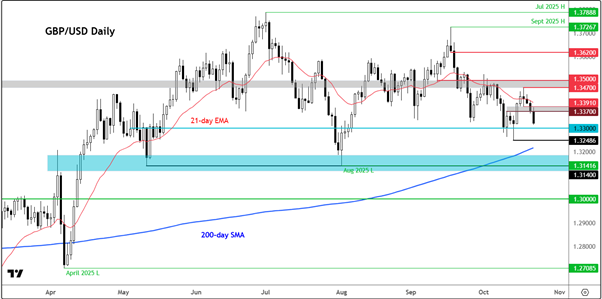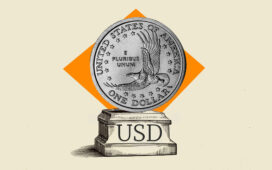- GBP/USD slipped to 1.33 as softer UK inflation raised December rate-cut expectations.
- BoE may pause further cuts due to sticky services inflation and fiscal pressures.
- US data, global PMIs, and FOMC decisions could drive near-term pound volatility.
- Looking for actionable trade ideas to navigate the current market volatility? Subscribe here to unlock access to InvestingPro’s AI-selected stock winners.
The came under renewed pressure this morning after a notably softer UK print prompted traders to price in a higher probability of a December . The GBP/USD slipped roughly 0.4%, hovering just above the 1.33 handle as the rose on rate-cut hopes.
The timing couldn’t be more delicate, with US data and global due Friday, followed by next week’s . For now, the pound’s near-term path looks uncertain, though not yet decisively bearish.
BoE Faces Dovish Tilt Amid Cooling Inflation
September’s inflation data has dealt the Bank of England a clear dose of dovish medicine, sending the GBP/USD exchange rate lower. held steady at 3.8%, undershooting expectations of 4.0%, while eased slightly to 3.5% against forecasts for an uptick. Even , long the BoE’s biggest headache, came in a touch softer than expected.
Perhaps the most encouraging sign for policymakers came from food prices, which fell in the month, now around half a percentage point below the Bank’s August forecast. This could mark the beginning of more sustainable disinflation ahead of early 2025, assuming no major supply shocks.
Markets now assign roughly a 70% chance of a December rate cut, with about 10 basis points of easing priced in. A firmer tone in the Autumn Budget, focusing on fiscal restraint, would likely cement those expectations further.
UK to Leapfrog US in Interest Rates Leader Board
Until now, the Bank of England has been among the more hawkish of major central banks during the ongoing global easing phase. Yet, the pound hasn’t been able to break cleanly away from the long-term $1.30-$1.40 resistance area, with the US Dollar Index chart repeatedly finding good support around the 96.50 – 97.50 area in the last couple of months.
The cable has spent nearly all of the summer oscillating around the $1.35 handle. That’s despite the fact that the US Federal Reserve has started to cut interest rates again amid concerns over the jobs market.
Now, the base rate in the UK is a high 4.0%, only second to the US rates, which are 25 basis points higher. But that 25 basis point spread is soon to be wiped out if the Fed delivers its expected 2 more rate cuts before the year is out, while the BoE potentially cuts only in December or stays put until inflation falls even further.
Against that backdrop, the long-term direction of the GBP/USD should be bullish, you’d think. But why hasn’t the cable pulled itself higher?
Well, the main reason the UK interest rates are still this high is not because of growth, but due to the sticky nature of services inflation, which has been quite damaging until now, although there was a bit of weakness here in today’s inflation report. The BoE wants to cut rates further because the economy needs lower rates, but can’t because of still-high services inflation.
But there is more to the pound’s struggles than just the interest rates outlook…
UK’s Fiscal Hole Provides a Drag on GBP
The UK faces a fiscal hole thought to be in the region of £25 billion. Chancellor Rachel Reeves somehow needs to fill this hole, which puts all the focus on the upcoming Autumn budget. Slower economic growth has equated to lower tax revenues, while higher bond yields have simultaneously pushed up debt interest projections, making it necessary to either cut spending or increase taxes, or both, to balance the books.
All these measures will surely be a burden on the economy, and it is precisely for this reason that investors have restrained themselves from sharply bidding up the GBP/USD at a time when the US economy is also weakening, and interest rates are being cut. With UK CPI remaining elevated, the BoE is unlikely to deliver another rate cut on November 6, especially given that the Autumn budget will be announced later that month on 26th November.
So, Why Hasn’t the GBP/USD Dropped More?
Today’s weaker CPI has pushed the cable down to near 1.33 handle, but you’d have thought that with inflation weakening and the UK’s fiscal woes also in the background, the GBP/USD might be closer to 1.30 than here. But a combination of positive factors has helped to keep the exchange rate relatively elevated, not least the US dollar’s own weakening story.
Here, the US government shutdown has been delaying US data releases, and the ongoing risk-on mode amid optimism over US-China trade talks has kept foreign currencies mildly supported on the dips.
US Inflation Data Still to Come This Week
There should be some more volatility expected in the next couple of days, with investors eying the delayed US inflation data on Friday, and the latest global PMI data for clues on the health of the world’s top economies.
The likely Fed rate cut next week, and the BoE hold, should mean the downside will be limited for the GBP/USD unless fiscal worries intensify like we saw during Liz Truss’s disastrous reign a couple of years ago.
GBP/USD Technical Analysis and Trade Ideas
Neutral is how I see the GBP/USD trend from a technical point of view right now, which can be visually observed by a quick glance at the daily chart:

The prior bullish momentum in the GBP/USD chart has been lost since around the start of the summer. Since then, rates have been in a consolidation mode around the mid $1.30s. This consolidation has also been reflected in the 21-day moving average flattening and turning a bit lower.
The longer-term 200-day simple moving average, meanwhile, is still pointing higher, and the cable is holding above it, to suggest the underlying trend remains bullish despite the choppy price action.
Still, the bulls must feel frustrated by the lack of significant follow-through after the pair looked like it had formed a low on Tuesday of last week. That breakout ran out of steam ahead of the 1.35 handle. But the downside has so far been limited. Short-term support around 1.3300 remains intact, below which the 200-day comes in at just north of 1.3200.
Meanwhile, resistance is now seen around the 1.3370-90 area, formerly support. Above that, 1.3470-1.3500 is the next key area of resistance to watch.
***
- AI-managed stock market strategies re-evaluated monthly.
- 10 years of historical financial data for thousands of global stocks.
- A database of investor, billionaire, and hedge fund positions.
- And many other tools that help tens of thousands of investors outperform the market every day!
Not a Pro member yet? Check out our plans here.
Disclaimer: This article is written for informational purposes only; it does not constitute a solicitation, offer, advice, counsel or recommendation to invest as such it is not intended to incentivize the purchase of assets in any way. I would like to remind you that any type of asset, is evaluated from multiple perspectives and is highly risky and therefore, any investment decision and the associated risk remains with the investor.




